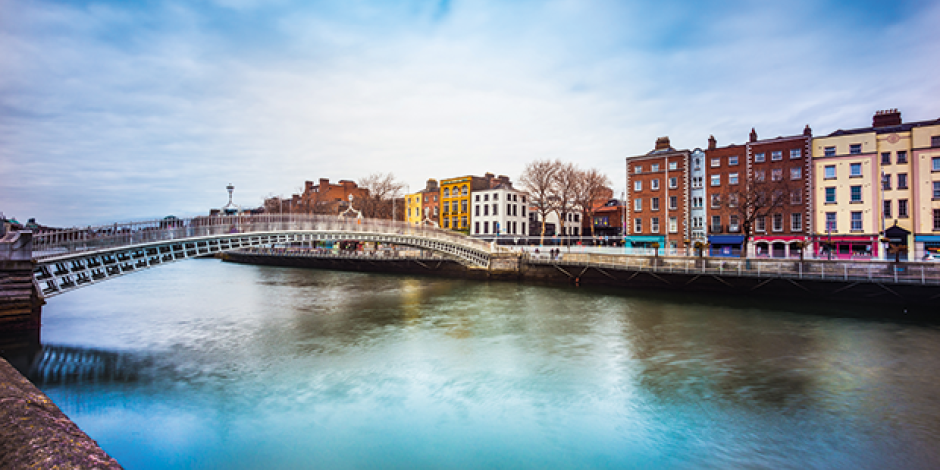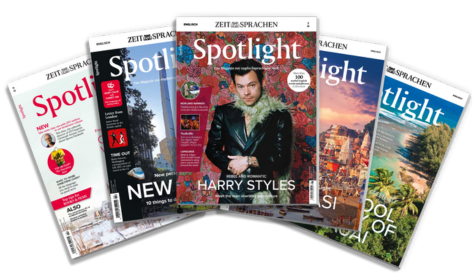I was happy that no one could see me, or at least almost no one. Maybe some people in the clubhouse nearby could, and Liam McCool certainly could. He had to: he was standing beside me, trying to teach me.
On a windy afternoon, I was at Deer Park Golf, where Liam, a PGA (Professional Golfers’ Association)Verein professioneller GolferPGA professional, is director. Deer Park is located in Howth, a fishing village just north of Dublin City, and offers two traditional golf courses, a nine-hole, par-three academy course, an 18-hole pitch-and-putt coursePlatz zum Abschlagen und Einlochenpitch-and-putt course and more. It’s set on the northern boundaryGrenzeboundary of Dublin Bay in the grounds of Howth Castle.
It was my first golf lesson ever, and it showed. But Liam was patient and encouraging, genuinelywirklich, echtgenuinely nice and conversational. And I was indeed improving, thanks to him, and very much enjoying myself. Afterwards, he took me into the clubhouse, where he bought me a Guinness and told me about the heathlandHeideland-heathland golf course and the surrounding area and castle. Only about a 30-minute train ride from the centre of Dublin, the spot seemed ideal for different kinds of travellers, even non-golfers What’s more, Liam and his colleagues are eagerbegierig, erpichteager to welcome more visitors to the area.
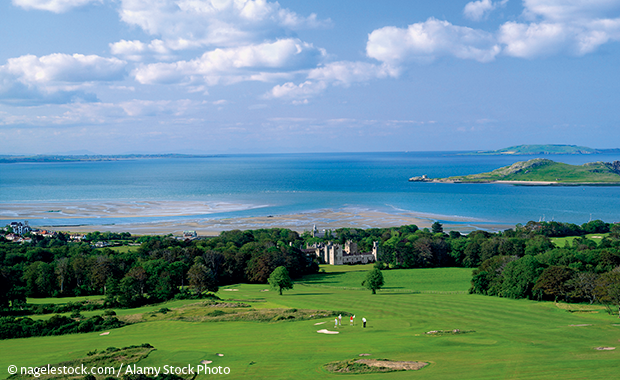
He and I took a golf cartGolfmobil, Golfwagengolf cart to the castle, where the owners of Deer Park, the St Lawrences, have lived since 1177. Two St Lawrence sisters-in-law opened the Howth Castle Cookery School in the castle’s restored Georgian kitchen ten years ago. throughout the yearganzjährigThroughout the year, hands-onzum Mitmachenhands-on cookery classes are offered in everything from Indian street food and MoorishmaurischMoorish vegetarian cooking, to knife skills and kitchen tips. The kitchen is gorgeousumwerfend, wunderschöngorgeous and vastgewaltig, riesigvast, and guests eat in what was once the servants’ kitchen. One can still see what’s left of the elaborateausgeklügelt, raffiniertelaborate bell system by which individual servants would be called upstairs. I can’t wait to return for more golf lessons and to take a cooking class. That’s a curious thing, as I don’t play golf and am not much interested in preparing food. But anything can happen when you visit Ireland.
Start up, slow down
The population of the Greater Dublin area is almost two million and growing fast, thanks to economic initiatives that have made the city attractive to multinational companies. This is partly due to the fallout(negative) Auswirkungenfallout from Brexit and to projects like the Digital Hub and Silicon Docks. But it is also because the city — as well as being a magnet for tourists from around the world (Germans rank third among its visitors) — is a busy centre of cultural, intellectual, culinary and even outdoor life. Dublin is a very vibrantpulsierend, lebendigvibrant city.
Walking helps to ensure that the sightseeing does not become overwhelming, as does having a guide to oneself
For those visiting the Irish capital for the first time, I recommend taking a personalized, guided walking tour. The city centre is filled with tourists and offers something for every kind of visitor. There are hop-on/hop-off buses, tour groups — everything you would expect. Walking helps to ensure that the sightseeing does not become overwhelmingüberwältigendoverwhelming, as does having a guide to oneself.
During my first morning in town, I was to be fortunateGlück habenfortunate to have a walking tour with Rachael Kummert. She is a founder and director of Walk in Dublin, a company that gives city tours in English and German. We walked to the City Hall, where she introduced me to the history of the great Irish pacifist and liberator, Daniel O’Connell, who was the driving force behind the Catholic Emancipation of 1829.Important for me was that the tour offered a broad historical perspective of the complex and rich history of Ireland, with great attention paid to architectural and cultural details. It was entirelyvöllig, totalentirely engrossingfesselndengrossing. Rachael advised me on what books to read, especially A History of Ireland in 250 Episodes by Jonathan Bardon — a great introduction to Irish history. She also recommended theatres, galleries and libraries to visit, as well as where to go to learn about Irish whiskeys — at the Celtic Whiskey Shop on Dawson Street, and the Irish Whiskey Museum on Grafton Street. Her storytelling and tips gave me a better appreciationWertschätzung, Verständnisappreciation of the city and its fascinating social and political history than a large tour group would have done, and it certainly helped to shape the rest of my stay. As part of the tour, we took in Christ Church Cathedral, Trinity College, the Temple Bar area and Dublin Castle — each one on its own worth a trip to the Irish capital.
Food for the soul
To get a feeling for another of Dublin’s famous aspects, food and drink, I recommend a different kind of tour. I met with a small group led by a guide from the Irish Food Trail, which organizes visits to some of the city’s best pubs and restaurants. This tour was immensely informative, but after three restaurants and pubs, I nearly required a napNickerchennap. During the tour and amidstinmittenamidst my painstakinggewissenhaftpainstaking journalistic fact-finding, I enjoyed Dublin coddleDubliner Eintopf mit Würstchen und SpeckDublin coddle, a “leftover breakfast”, a kind of stewEintopfstew consisting of whatever’s around, though usually with pork sausages, bacon, potatoes and onion. And although I had to bartendals Barkeeper(in) arbeitenbartended many years ago, I also learned that I had never made or enjoyed a proper Irish coffee. I didn’t know that the drink was a modern invention, and our guide demonstrated the art of making it. Believe it or not, a proper Irish coffee looks a bit like a pint of Guinness. It is very strong (thanks to the whiskey in it) and delicious, and the people at Oscars cafe and bar, directly opposite Christ Church, can show you how it should be made.
After a rest following my Dublin coddle and Irish coffee, I set out for Dublin’s oldest pub, the Brazen Head, which dates from 1198. This is a popular place among visitors, so a reservation is a must. The pub serves traditional Irish fareKostfare, which is accompanied by storytelling and music. It’s good fun.
Artful diversions
In addition to pubs, which are a cliché of all that’s warm and welcoming in Dublin, contemporary culture plays a big part in defining the city. The James Joyce Centre is located in a townhouse built in 1784 that was once home to a dance academy run by a character who appears several times in Joyce’s Ulysses. The centre hostveranstaltenhosts lectureVortraglectures, permanent and temporary exhibitions, interactive installations and films. Amazingly, it is an interesting and informative resource for the initiatedEingeweihter(r)-initiated and uninitiated alike. I admit that I never had the reading staminaAusdauerstamina to make it through Ulysses. Yet, the centre offers fascinating glimpse(flüchtiger) Blickglimpses into this leading Irish writer’s life, how he lived and the censorshipZensur-censorship battles surrounding his greatest novel. Meanwhile, interactive computer installations enable more rigorousstreng, peinlich genaurigorous scholarGelehrte(r)scholars to examine his life year by year, and the novel episode by episode.
The Dublin City Gallery, aka (also known as)aliasaka The Hugh Lane, is a four-minute walk from the Joyce centre. It’s also located in a townhouse — the Charlemont House — constructed in 1763. In 1929, the building was chosen as the home of the Municipal Gallery of Modern Art, which was founded by Sir Hugh Lane in 1908. Lane had been one of the leading collectors of Impressionist art in Europe, and acquireerwerbenacquired works by Degas, Vuillard, Renoir and Manet.
After decades of negotiations, most of this collection is now shared between the Dublin City Gallery and the National Gallery in London. When I visited, I had the opportunity to see Manet’s Portrait of Eva Gonzalès and Renoir’s The Umbrellas. The gallery also has a section dedicatedgewidmetdedicated to the works of Sean Scully, a reconstruction of the studio of Irish-born British artist Francis Bacon and rooms filled with works by many of Ireland’s other leading modern artists.
The Irish Museum of Modern Art makes brilliant and imaginative use of its old space: it is situated in the grounds of the Royal Hospital Kilmainham, one of the finest 17th-century buildings in Ireland
Catch a bus that goes past the Guinness storehouses, and in a few minutes, you will arrive at the Irish Museum of Modern Art, or IMMA, as it’s known. This is home to more than 3,000 works of art, and it featurezeigen, darbietenfeatures exhibitions and projects by top Irish and international artists. It has an extensive community outreach programme which works to engage people of diverse backgrounds, interests and ages in the institution’s activities and educational projects. IMMA makes brilliant and imaginative use of its old space: it is situated in the grounds of the Royal Hospital Kilmainham, one of the finest 17th-century buildings in Ireland. A home for retired soldiers, it was inspired in its design and function by Les Invalides in Paris.
The Kilmainham grounds area is rich in history. It was the location of ancient burial groundGrabstätteburial grounds, early Christian monuments, a Viking settlement and a medievalmittelalterlichmedieval monasteryKlostermonastery. Its great size allows for many fascinating exhibitions: IMMA is in the middle of a five-year show focusing on Lucian Freud, with 52 of his works on loan, but also featuring work by Emily Dickinson, Sigmund Freud, Marlene Dumas and John Berger.
Country interlude
It is remarkable how little time it takes to get from the centre of Dublin to small villages that feel far removed from the city. Going out to where my journey began, I met Shane O’Doherty of Shane’s Howth Hikes. He took me and five other people for a couple of hours of trekking along the hills near the village. Shane is an effusiveüberschwänglicheffusive guy who wants you to enjoy and learn about his village and, indeed, the whole area — a lover of history and nature. He carefully to gaugeabschätzen, abwägengauged our walking abilities and made sure that we went at a speed we could all manage, including your intrepidunerschrockenintrepid correspondent.
We walked along the hilly Howth Head Peninsula, which overlooks Dublin Bay. The scents of this natural setting were refreshing and magical. gorseGinsterGorse — a native shrubBuschshrub with a yellow pea flower that smells like coconut — was to bloomblühenblooming everywhere. Wild garlic was also growing all round, to blend with sth.gut zu etw. passenblending with the sea air, and it was a pleasure to to nibbleknabbernnibble on the garlic leaves as we walked. The hills are covered with old beech treeBuchebeech trees, although they are not native to Ireland. They were first planted on the island in the 18th century, to the detrimentNachteil, Schadendetriment of native plants that to witherverwelken, verdorrenwithered in the shadow of the larger trees. Like the rest of Ireland, this area is a birdwatcher’s paradise. We observed seagullSeemöweseagulls bathing in a lake to wash off the salt. We saw oystercatcherAusternfischeroystercatchers and cormorantKormorancormorants (also known as shags); and one is likely to find heronReiherherons, gannetTölpelgannets and many other birds here as well.
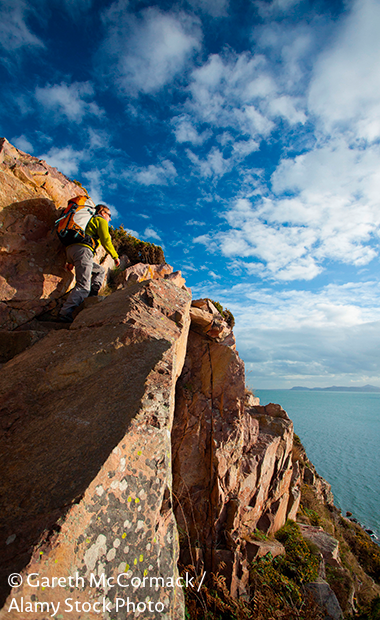
Climbing the stone steps along Red Rock on the Howth Coastal Path
Unfortunately, on this visit, I didn’t have time to go fishing, but Shane told me that the most common catches in the area are mackerelMakrelemackerel, mulletMeeräschemullet and codlingjunger Dorschcodling (or “little cod”). And of course, this is the home of the famous and succulentwohlschmeckendsucculent Dublin Bay prawnKaisergranatDublin Bay prawn.
A fine farewell
That night back in Dublin, I had dinner at Delahunt, a restaurant near my hotel and St Stephen’s Green. It was my last night in town, and I was thinking of the extraordinary richness and diversity of my three days there. I had so genuinely enjoyed my time with Rachael, Liam, Shane and the others who had shown me around the city and its sights, museums and other cultural institutions.
People here work very hard to share their knowledge of the things they love — Trinity College, golf, IMMA, The Umbrellas, coddle, the beauty and nature of Howth — so that others will love them, too. I felt sad to leave, but eager to plan my next visit. I ordered short ribsQuerrippe, Leiterstückshort ribs — a wonderful choice — with toasted barleyGerstebarley risotto and local garlic. After all, there’s nothing like a little more Irish wild garlic to round off the day.
If you go...
Getting there
Fly to Dublin with AerLingus
Where to stay and eat
- Iveagh Garden Hotel, recently opened
- Dublin’s oldest pub, the Brazen Head
- Delahunt restaurant
What to do
- Deer Park Golf, Howth
- Walk in Dublin tours
- Irish Food Trail tours
- Irish Museum of Modern Art
- Shane’s Howth Hikes
More information
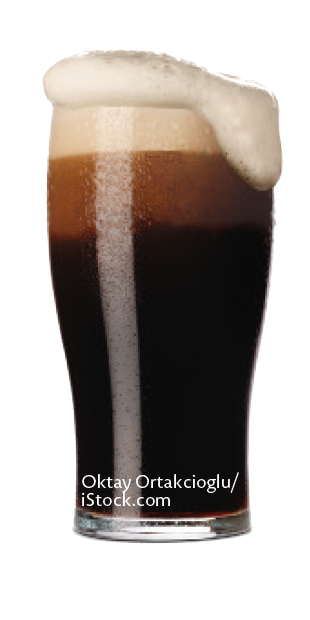
Neugierig auf mehr?
Dann nutzen Sie die Möglichkeit und stellen Sie sich Ihr optimales Abo ganz nach Ihren Wünschen zusammen.


